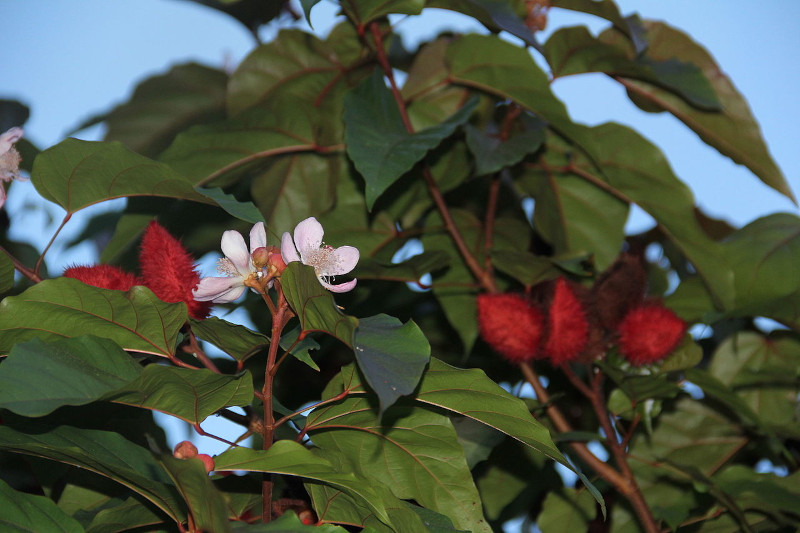
Achiote Tree Facts
- The intriguing term of Achiote Tree actually represents only one of several common names for this remarkable product of Nature and evolution. Others titles for the marvel include such terms as Annatto tree, Lipstick tree, Bixa tree, Bixin tree, Roucou tree, and Urucum tree.
- Among scientific professionals, however, the plant’s perhaps better known by its technical designation. Fortunately, though, that appellation remains much easier for the layperson to pronounce than many such tags. The plant holds the official epithet of Bixa orellana.
- This marvelous Angiosperm received that moniker due to the efforts of Carl Linnaeus himself. The highly esteemed Swedish biologist accomplished the first recognition of it as a separate and distinct species. He achieved that scientifically noteworthy deed in the year 1753.
- Indigenous Peoples knew of and appreciated this marvel of Naure long before European explorers encountered it. They both enjoyed its remarkable beauty and made use of the flora in a variety of ways. Some of these included making body paint and a spice for consumption.
- Thankfully, the stunning Achiote Tree seems to be maintaining a population base that’s both stable and sufficient. That pleasant fact further appears to hold true throughout its entire range. The IUCN thus currently lists it as Least Concern on its Red List of Threatened Species.
- The stunning flora nevertheless still faces numerous potential threats to its continued existence, at least. Like all species alive today, many of these stem from the actions of mankind. They include both the closely related dangers of habitat loss and ongoing climate change.
Related Articles
Achiote Tree Physical Description
The wonderful Achiote Tree typically grabs the attention of those individuals fortunate enough to encounter it, and for a variety of reasons. Certainly, its charming appearance ranks high among these factors, to be certain. Yet, it also has a variable nature that appeals to numerous viewers.
That’s due to the fact that, depending on local conditions, this particular flora evolved the ability to develop as either a small to medium-sized tree. An average height ranges from roughly 20 – 26 ft (6 – 8 m). Exceptional specimens, however, sometimes attain measurments of 33 ft (10 m).
Its intriguing trunk develops as relatively thick in relation to its height. That factor’s especially true at the base. This part of the tree also tends to extend roughly vertically. Its grayish-brown bark appears quite smooth in its youth, but roughens as it ages, acquiring fissures and vertical cracks.
Not to be out done, though, the foliage of the fabulous plant also properly garners appreciation. These leaves generally develop as comparatively large, heart-shaped, and appear glossy green. Each manifests itself arranged alternately on the branches and displays highly prominent veins.
Yet, it’s most probably the flowers of the captivating Achiote Tree that most frequently mesmerize the viewer. These gorgeous blooms develop in relatively small clusters, each averaging about 2 in (5 cm) in diameter. In color, these wonders present shades of either white, pink, or lavender.
The most unusual feature of this incredible plant, meanwhile, doubtless remains its spiky, reddish-brown fruit pods. These portions of the tree measure about 2 – 3 in ( 5 -7 cm) in diameter. Each of these very distinctive pod contains numerous small seeds embedded in a bright red pulp.
- Kingdom: Plantae
- Phylum: Tracheophyta
- Class: Magnoliopsida
- Order: Malvales
- Family: Bixaceae
- Genus: Bixa
- Species: B. orellana
Achiote Tree Distribuition, Habitat, and Ecology
The beautiful Achiote Tree evolved as native to only a moderate portion of the surface of the earth. Given its nature, however, the location of that zone of habitation probably won’t surprise many people who learn of it. That’s because it’s endemic to certain parts of Central and South America.
Within that region, though, it’s most commonly found naturally occuring within the borders of several countries. These locations include the countries of Mexico, Brazil, Peru, Colombia, and Venezuela. But, it also appears in parts of the Caribbean. Man’s also now introduced it elsewhere.
Though it displays a powerful preference for certain types of habitat, it nonetheless also displays a moderate degree of flexibility in this regard when necessary. It therefore lives in a broad range of ecosystems. These typically include regions with warm temperatures and high humidity.
It’s commonly found in areas formed of lowland tropical rainforests, although it also has the ability to grow in other types of forests. These include tropical dry forests and tropical moist forests. This remarkable Angiosperm also prefers well-drained soils with good moisture retention.
The breathtaking Achiote Tree achieves pollination of its blooms via the actions of various locally numerous insects, primarily including bees and butterflies. These visit the tree to feed on its sweet nectar. Later, the seeds are dispersed by various animals that consume the fruits of the tree.
The fascinating product of evolution further contributes to the biodiversity of the tropical forests it grows in by providing habitat and food for various organisms. Birds, such as parrots and toucans, are known to frequently feed on the seeds of the tree. Countless others use its branches for shelter.
Species Sharing Its Range
Check out our other articles on 4 Radiant Red Sea Creatures, Japanese Dwarf Flying Squirrel, Yellowstone Lake, Common Water Hyacinth, Great Barracuda, Blue-winged Wasp, Green Iguana
